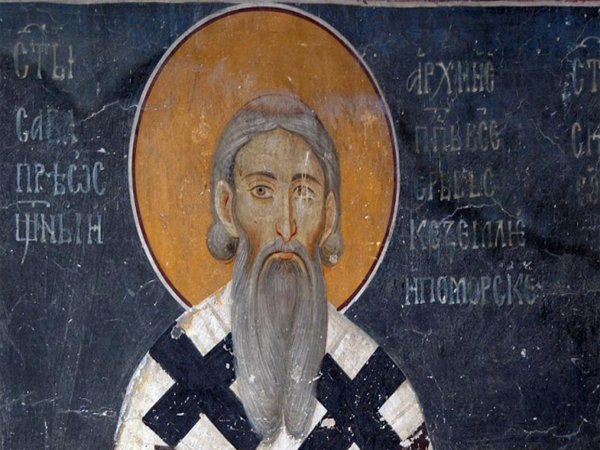
( Date of birth is not precisely defined)
Sava was born Rastko Nemanjić (Растко Немањић, pronounced [râstkɔ nɛ̌maɲitɕ]), the youngest son of Serbian Grand Prince Stefan Nemanja (founder of the Nemanjić dynasty), and ruled the appanage of Hum briefly in 1190–1192. He became a monk in his youth, receiving the monastic name Sava (Sabbas), subsequently founding the monasteries of Hilandar on Mount Athos, and Žiča. In 1219 he was recognized as the first Archbishop of Serbs, by the Patriarch of Constantinople, and in the same year he authored the oldest known constitution of Serbia, Zakonopravilo, thus securing full independence; both religious and political. Sava heavily influenced Serbian medieval literature. He is widely considered as one of the most important figures of Serbian history, and is canonized and venerated by the Serbian Orthodox Church, as its founder, on January 27. His life and has been interpreted in many artistic works from the Middle Ages to modern times. He is the patron saint of Serbian schools and schoolchildren. The Cathedral of Saint Sava in Belgrade is dedicated to him, it was built on the scene where the Turks burnt his remains in the 16th century, following an uprising in which the Serbs used icon depictions of Sava as their war flags; the cathedral is currently the largest Eastern Christian church building in the world.
Rastko (from Rastislav) was born in 1169 or 1174, in Gradina (modern Podgorica, Montenegro). He was the youngest son of Grand Prince Stefan Nemanja and Anastasija. He is part of the first generation of the Nemanjić dynasty. In 1190–92, he was assigned the rule of Hum, which was previously held by his uncle Miroslav of Hum, who continued to hold the Lim region with Bijelo Polje while Rastko held Hum. When Rastko took monastic vows, Miroslav most likely continued as ruler of Hum.
Monastic vows n the autumn of 1192 (or shortly thereafter), he joined a Russian monk, giving alms to the St. Panteleimon monastery of Mount Athos, where he received the monastic name of Sava (Sabbas). They did not stay long, leaving for the Greek Vatopedi. His father sent messengers to Athos for the return of Sava to Serbia, but in vain. Sava replied to his father: "You have accomplished all that a Christian sovereign should do; come now and join me in the true Christian life".
The Karyes Typicon with the authentic signature of Saint Sava from 1199 – one of the oldest Serbian documents in the monastery of Hilandar, (detail)
Nemanja arrived at Mount Athos on March 25, 1195, and took monastic vows under the name Simeon. The father and son asked the Holy Community for the establishment of the Serbian religious base at the abandoned Chilandar, which they renovated, marking the beginning of cultural prospering (in arts; literature, and religion). His father Nemanja died in Hilandar on February 13, 1199, and was canonized as Saint Simeon. Nemanja had earlier decided to give the rule to Stefan (II) (henceforth referred to as Stefan), and not the eldest, Vukan. Sava built a church and cell at Karyes, where he stayed for some years, becoming a hieromonk, then an archimandrite in 1201. He wrote the Karyes Typicon during his stay, of which a marble inscription of his work still exist.
In the meantime, back home, Vukan began plotting against his brother Stefan; he found an ally in Emeric, the King of Hungary, and together they banished Stefan to Bulgaria, and Vukan usurped the Serbian throne. Stefan returned to Serbia with an army in 1204, and pushed Vukan to his maritime appanage in Zeta. After problems at the Holy Mountain with Latin bishops (Boniface of Montferrat), Sava returned to Serbia in the winter of 1205–06 or 1206–07, with the remains of his father which he relocated to the Studenica monastery, and reconciled his two brothers. Stefan asked him to remain in Serbia with his clerics, which he did, beginning a widespread pastoral and educational duty to the people of Serbia. He founded several churches and monasteries, among which was the Žiča monastery.
Stefan asked him to remain in Serbia with his clerics, which he did, beginning a widespread pastoral and educational duty to the people of Serbia. He founded several churches and monasteries, among which was the Žiča monastery.
